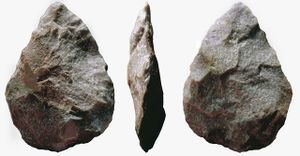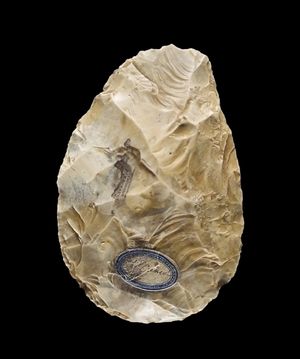أشولية
 | |
| النطاق الجغرافي | Africa, Europe, and Asia |
|---|---|
| الفترة | Lower Paleolithic |
| التواريخ | 1.76–0.13 Mya |
| الموقع النمطي | Saint-Acheul (Amiens) |
| سبقها | Oldowan |
| تلاها | Mousterian, Clactonian, Micoquien |
| العصر الحجري |
|---|
| ↑ قبل Homo (پليوسين) |
|
| ↓ العصر النحاسي |
أشولية أو حضارة أشولية (Acheulean) هي مرحلة صناعية في عصر ماقبل التاريخ بمنطقة مدينة سانت آشول بشمال فرنسا. ويتميز هذا الموقع الأثري بكثافة الآثار من البلط الحجرية التي لها أيدي والآلات الحجرية المصقولة كالفؤوس المدببة والبيضاوية التي كان يستعملها الإنسان الأول . وبوفرة وأكثر مما وجد في مواقع أولدفاي بشرق أفريقيا . وأصبحت الأشولينية مصطلحا يطلقه علماء الآثار علي مواقع لصناعة البلط اليدوية المدببة والمفلطحة والمكاشط من الحجر المصقول لذبح الحيوانات وتجهيزها . ويرجع تاريخها لعصر ماقبل التاريخ في أفريقيا والشرق الأدني وأوربا وآسيا ويرجع تاريخها إلي 5,1 مليون سنة وحتي 200,000 سنة .و هذه المرحلة تطورية حبث تحول الإنسان المنتصب Homo erectus لإنسان عاقل Homo sapiens .ويطلق علي إنسان هذا العصر الإنسان الأشولي الذي عاش قرب الأنهار في أوروبا وأفريقيا وآسيا وظهرت مصنوعات خشبية ترجع للمرحلة الأشولية كالحراب التي عثر عليها شوننگن بألمانيا وكلاتون بإنجلترا . ويرجح العلماء أن الإنسان الأشوليني إستخدم النار منذ 300 ألف سنة عندما عثروا علي بقايا عظام وأحجار محروقة وفحم ورماد في عدة مواقع أشولينية كما في كهف المواقد Cave of Hearths بجنوب أفريقيا وزوكوديان بالصين وتـِرّا أماتا بفرنسا. لكن لاتوجد مواقد نيران تذكر بهذه الفترة .
الأدوات الحجرية الأشولية

التوزيع
انظر أيضاً
- Lithic reduction
- العصر الحجري
- Synoptic table of the principal old world prehistoric cultures
- Stone tools
المصادر
- Pappu, Raghunath (2001). Acheulean Culture in Peninsular India: An Ecological Perspective. New Delhi: D K Printworld. ISBN 81-246-0168-2.
{{cite book}}: Cite has empty unknown parameters:|coauthors=and|month=(help) - Adkins, L (1998). The Handbook of British Archaeology. London: Constable. ISBN 0-09-478330-6.
{{cite book}}: Cite has empty unknown parameter:|month=(help); Unknown parameter|coauthors=ignored (|author=suggested) (help) - Butler, C (2005). Prehistoric Flintwork. Tempus, Stroud. ISBN 0-7524-3340-7 begin_of_the_skype_highlighting 0-7524-3340-7 end_of_the_skype_highlighting begin_of_the_skype_highlighting 0-7524-3340-7 end_of_the_skype_highlighting.
{{cite book}}: Check|isbn=value: invalid character (help); Cite has empty unknown parameters:|coauthors=and|month=(help); no-break space character in|isbn=at position 46 (help) - Darvill, T (ed.) (2003). Oxford Concise Dictionary of Archaeology. Oxford: Oxford University Press. ISBN 0-19-280005-1.
{{cite book}}:|first=has generic name (help); Cite has empty unknown parameters:|coauthors=and|month=(help) - Milliken, S (2001). A Very Remote Period Indeed. Papers on the Palaeolithic presented to Derek Roe. Oxford: Oxbow. ISBN 1-84217-056-2.
{{cite book}}: Cite has empty unknown parameter:|month=(help); Unknown parameter|coauthors=ignored (|author=suggested) (help) - Renfrew, C (1991). Archaeology, Theories Methods and Practice. London: Thames and Hudson. ISBN 0-500-27605-6.
{{cite book}}: Cite has empty unknown parameter:|month=(help); Unknown parameter|coauthors=ignored (|author=suggested) (help) - Scarre, C (ed.) (2005). The Human Past. London: Thames and Hudson. ISBN 0-500-28531-4.
{{cite book}}:|first=has generic name (help); Cite has empty unknown parameters:|coauthors=and|month=(help) - Wood, B (2005). Human Evolution A Very Short Introduction. Oxford: Oxford University Press. ISBN 0-19-280360-3.
{{cite book}}: Cite has empty unknown parameters:|coauthors=and|month=(help)
- ^ Bar-Yosef, O and Belfer-Cohen, A, 2001, From Africa to Eurasia — Early Dispersals, Quaternary International 75, 19–28, Abstract
- ^ Scarre, C, 2005, p110
- ^ Clark, JD, Variability in primary and secondary technologies of the Later Acheulian in Africa in Milliken, S and Cook, J (eds), 2001
- ^ Roche H and Kibunjia, M, 1994, Les sites archaéologiques plio-pléistocènes de la formation de Nachukui, West Turkana, Kenya: bilan synthétique 1997–2001, Comptes Rendus de l'Académie des Sciences, Paris 318 (Série II), 1145–51, qtd in Scarre, 2005
- ^ Roche H et al., 2002, Les sites archaéologiques pio-pléistocènes de la formation de Nachukui, Ouest-Turkana, Kenya: bilan synthétique 1997–2001, Comptes Rendus Palevol 2, 663–673, qtd in Scarre, 2005
- ^ Wood, B, 2005, p87.
- ^ Ashton, N, McNabb, J, Irving, B, Lewis, S and Parfitt, S Contemporaneity of Clactonian and Acheulian flint industries at Barnham, Suffolk Antiquity 68, 260, p585–589 Abstract
- ^ Clark, JD et al., 1966, Precision and definition in African archaeology, South African Archaeological Bulletin XXI (83), 114–21 qtd in Scarre, 2005
- ^ Barton, RNE, Stone Age Britain English Heritage/BT Batsford:London 1997 qtd in Butler, 2005. See also Wymer, JJ, The Lower Palaeolithic Occupation of Britain, Wessex Archaeology and English Heritage, 1999.
- ^ Ashton, NM, McNabb, J, and Parfitt, S, Choppers and the Clactonian, a reinvestigation, Proceedings of the Prehistoric Society 58, pp21–28, qtd in Butler, 2005
- ^ Wymer, JJ, 1968, Lower Palaeolithic Archaeology in Britain: as represented by the Thames Valley, qtd in Adkins, L and R, 1998
- ^ Collins, D, 1978, Early Man in West Middlesex, qtd in Adkins, L and R, 1998
- ^ Paddayya, K, Jhaldiyal, R and Petraglia, MD, Excavation of an Acheulian workshop at Isampur, Karnataka (India) Antiquity 74, 286, pp 751–752 Abstract
- ^ Gamble, C and Steele, J, 1999, Hominid ranging patterns and dietary strategies in Ullrich, H (ed.), Hominid evolution: lifestyles and survival strategies, pp 396–409, Gelsenkirchen: Edition Archaea.
- ^ Unattributed citation in Renfrew and Bahn, 1991, p277
- ^ O'Brien, E, 1981, The projectile capabilities of an Acheulian handaxe from Olorgesailie, Current Anthropology 22: 76–9. See also Calvin, W, 1993, The unitary hypothesis: a common neural circuitry for novel manipulations, language, plan-ahead and throwing, in K.R. Gibson & T. Ingold (ed.), Tools, language and cognition in human evolution: 230–50. Cambridge: Cambridge University Press.
- ^ Gamble, C, 1997, Handaxes and palaeolithic individuals, in N. Ashton, F. Healey & P.Pettitt (ed.), Stone Age archaeology: 105–9. Oxford: Oxbow Books. Monograph 102.
- ^ White, MJ, 1998, On the significance of Acheulian biface variability in southern Britain, Proceedings of the Prehistoric Society 64: 15–44.
- ^ Kohn, M and Mithen, S, 1999, Handaxes: products of sexual selection?, Antiquity 73, 518–26 Abstract
- ^ Todd, L, Glantz, M and Kappelman, J, Chilga Kernet: an Acheulean landscape on Ethiopia's western plateau Antiquity 76, 293 pp 611–612 Abstract
- ^ Biglari, F. and Shidrang, S. 2006 The Lower Paleolithic Occupation of Iran, Near Eastern Archaeology 69(3–4): 160-168 [1]
- ^ Hyeong Woo Lee, The Palaeolithic industries of Korea: chronology and related new findspots in Milliken, S and Cook, J (eds), 2001
- ^ Gamble, C and Marshall, G, The shape of handaxes, the structure of the Acheulian world, in Milliken, S and Cook, J (eds), 2001
- ^ Clarke, JD et al., 2003, Stratigraphic, chronological and behavioural contexts of Pleistocene Homo sapiens from Middle Awash, Ethiopia, Nature 423, 747–52, Abstract
- ^ Isaac, GL, 1976, Stages of cultural elaboration in the Pleistocene: possible archaeological indicators of the development of language capabilities, in Origins and Evolution of Languages and Speech (SR Harbard et al. eds.), 276–88, Annals of the New York Academy of Sciences 280, qtd in Renfrew and Bahn, 1991
- ^ Wynne, T, 1995, Handaxe enigmas, World Archaeology 27, 10–24, qtd in Scarre, 2005
- ^ Dibble, HL, 1989, The implications of stone tool types for the presenceof language during the Lower and Middle Palaeolithic, in The Human Revolution (P Mellars and C Stringer eds) Edinburgh University Press, qtd in Renfrew and Bahn, 1991.
- ^ Goren-Inbar, N and Peltz, S, 1995, Additional remarks on the Berekhat Ram figure, Rock Art Research 12, 131–132, qtd in Scarre, 2005
- ^ Mania, D and Mania, U, 1988, Deliberate engravings on bone artefacts of Homo Erectus, Rock Art Research 5, 919–7, qtd in Scarre, 2005
- ^ Tryon, CA and McBrearty, S, 2002, Tephrostatigraphy and the Acheulean to Middle Stone Age transition in the Kapthurin Formation, Kenya, Journal of Human Evolution 42, 211–35, qtd in Scarre, 2005 Abstract
- ^ Cruz-Uribe, K et al., 2003, Excavation of buried late Acheulean (mid-Quaternary) land surfaces at Duinefontein 2, West Cape Province, South Africa, Journal of Archaeological Science 30, 559–75, qtd in Scarre, 2005
- ^ Scarre, 2005, chapter 3 , p118 "However, objects whose artistic meaning is unequivocal become commonplace only after 50,000 years ago, when they are associated with the origins and spread of fully modern humans from Africa.
- ^ ...the most conservative conclusion today is that Acheulean people and their contemporaries definitely hunted big animals, though their success rate is not clear ibid, p 120.
- ^ De Lumley, 1975, Cultural evolution in France in its palaeoecological setting during the middle Pleistocene, in After the Australopithecines, Butzer, KW and Issac, G Ll. (eds) 745–808. The Hague:Mouton, qtd in Scarre, 2005
مصادر اضافية
وصلات خارجية
- Acheulian Tools of North Africa — World Museum of Man
- Acheulian Tools of Europe — World Museum of Man
- Acheulean Gallery
- Acheulean tools from Britain [broken link]
- Acheulian Iran
- Lower Paleolithic Iran [broken link]
- Acheulian Armenia [broken link]
- "Acheulian Project". Archived from the original on 2006-09-25.
- Acheulean France [broken link]
- Early human fire skills revealed
- The Acheulian biface project: a digital archive for teaching and research
- Acheulean replacing Cheulean crafts [linked page is not about acheulean]
| Acheulean
]].

